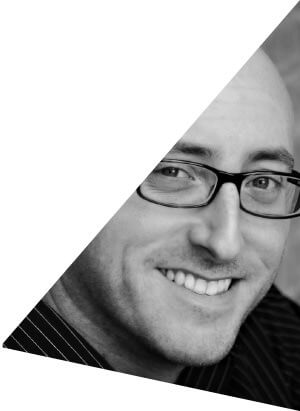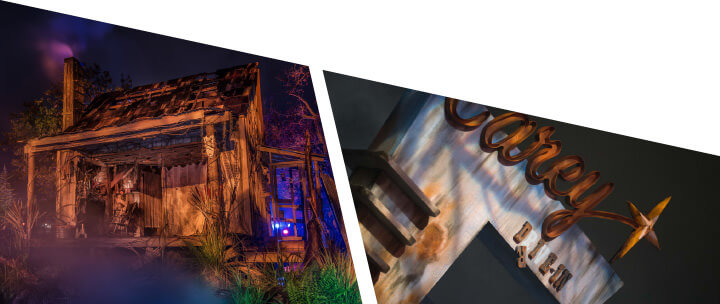 After graduating cum laude from Shenandoah Conservatory with a Bachelor of Arts in Theatre, with a scenic and lighting design concentration, he transformed that passion into an impressive career, which includes extensive freelance design work under the name See-Nick-Design, as well as his current position as a senior scenic designer in the Entertainment Art & Design Department for Universal Orlando Resort in Orlando, Florida.
After graduating cum laude from Shenandoah Conservatory with a Bachelor of Arts in Theatre, with a scenic and lighting design concentration, he transformed that passion into an impressive career, which includes extensive freelance design work under the name See-Nick-Design, as well as his current position as a senior scenic designer in the Entertainment Art & Design Department for Universal Orlando Resort in Orlando, Florida.
“He’s amazing,” Scenic and Lighting Director and Associate Professor of Theatre William Pierson, M.F.A., said. “He’s one of our best alumni that we’ve had through this program.” Collins was also one of the four alumni honored in early April with Shenandoah Conservatory’s 2016 Alumnus of Excellence Award.
For Collins, 38, who grew up in a small town near Six Flags Over Georgia and practiced special effects makeup techniques in his bedroom as a teen, the Universal job — through which he works on spectaculars and the park’s famed month-long, 25-year-old Halloween Horror Nights event — is a perfect fit.
“Our team is responsible for all the creative content on the entertainment side of things in the parks,” Collins said. He is only one of four scenic designers on his team, and they handle both Universal Orlando parks, which include Universal Studios Florida and Universal’s Islands of Adventure, he said. The entertainment side of things includes live shows, parades (such as a full Mardi Gras parade and the Macy’s Holiday Parade), spectaculars, and of course, Halloween Horror Nights (HHN), which he works on for about 11 months each year. The event draws over 500,000 visitors, who come to see nine full indoor haunted houses, five exterior scare zones and two live shows. Not many other venues provide designers with such a large audience for their work, Collins noted.

In 2015, Collins designed one of those live shows — a major undertaking marking the return of one of the Horror Nights’ iconic hosts, Jack the homicidal clown. Featuring pyrotechnics, clowns, aerial performers, special effects and magic, the show, called “The Carnage Returns,” included a slew of Nick’s favorite things. “It was like Nick’s Mix tape,” Collins said. The View from the Cheap Seats blog gave the show high marks during its run last year. “This is a can’t miss show and is an awesome cherry on top of every HHN fan’s wish list.”
While he designs major shows, he also pays attention to smaller projects, including character meet-and-greets, in-park photo opportunities and corporate events. He said there are days when his biggest worry is, “Does this brick look real?”
 At Universal, the scenic designers work within a larger group, but members of the quartet do have a great deal of control over their own work. “We’re almost like our own technical directors,” Collins said, adding that while they’re designers, they have the technical know-how to design things that they know can be built.
At Universal, the scenic designers work within a larger group, but members of the quartet do have a great deal of control over their own work. “We’re almost like our own technical directors,” Collins said, adding that while they’re designers, they have the technical know-how to design things that they know can be built.
At Shenandoah, he gained the knowledge he now uses daily. Here, he learned the process and craft required for designing sets and environments. He also discovered the importance of collaboration. He learned the hallmarks of traditional theatre design and had a work-study position in the construction shop.
“I really enjoyed my time in the shop,” he said. Additionally, he minored in acting, which he said made him a stronger designer, because he could understand design needs from an actor’s perspective (say, that a staircase must be easy to climb and descend).
Pierson recalls Collins as a very driven student, who was “by my side every minute.” Collins always asked questions, which is something Pierson said he likes students to do, because it makes him rethink his own choices. “[It’s] kind of refreshing to have somebody push you there.”
“Nick was very creative, talented, with a strong work ethic, a desire to succeed, and was, and is, one of the very nicest, down-to-earth people you could ever meet,” said Harold Herman, Endowed Chair in Musical Theatre, and Professor of Theatre William McConnell “Mac” Bozman, M.F.A.
Pierson also recently visited Collins at Universal while on sabbatical, to see his work and talk about how Shenandoah prepared him for his career. Collins took him through all nine haunted houses in one evening, and Pierson saw “The Carnage Returns,” as well. “The work is really, really strong,” Pierson said, adding that Collins said his Shenandoah education helped him understand construction and the aesthetics of live performance. He can also create on-site sketches. “He hand-drafts everything,” Pierson said.
“He’s a driven, driven young man,” Pierson said, noting that kind of drive is necessary to reach Collins’ level of success. His intensity was evident during the prep for “The Carnage Returns.” “It was grueling,” Collins said. “I came down with walking pneumonia during the production of the show.” By the way, Collins will design another show of similar size for Halloween 2016.
Collins discovered his passion for design at a young age. As a small child watching scary movies, his mother would reassure him that nothing on the screen was real, and that people had made the things that scared him. In addition, Six Flags Over Georgia was the closest entertainment to his home. And there, he was interested in knowing what was behind the metaphorical curtain and recalls tapping a “rock” wall to see how park pros made it. Always a tinkerer and builder, he sought out books about magic, puppetry and monster makeup.
 During his high school years, his mother encouraged his interest and connected him to an Atlanta theatre where he could help out and see how a theatre environment really worked. And by age 16, he was working at Six Flags, starting out as a backstage tech for a musical revue. He ended up working summers there for 12 years, doing everything from character work and pyrotechnics to stage management.
During his high school years, his mother encouraged his interest and connected him to an Atlanta theatre where he could help out and see how a theatre environment really worked. And by age 16, he was working at Six Flags, starting out as a backstage tech for a musical revue. He ended up working summers there for 12 years, doing everything from character work and pyrotechnics to stage management.
He loved themed entertainment and watching the regional design manager draw. It was then he learned that to have a job like the design manager’s, he needed to go to school. Somewhere along the way, he heard about Shenandoah.
Since he didn’t have design experience, he submitted a talent portfolio of his special effects makeup. He was accepted to the conservatory, giving up a free ride to a Georgia State University. He loved the beauty of the Shenandoah Valley and the conservatory’s small size, which allowed him to get personal attention from professors and really engage in dialogues with them. Those professors have also remained mentors, he said.
Technical Director, Chair of the Theatre Division and Associate Professor of Theatre William Ingham, M.F.A., recalls Collins vividly. “He was very intense about the direction his career was going to take, and that was toward theme park/event design. The best part about his intensity was his smile and great attitude.”
Ingham also noted how Collins’ career proved influential for him in his early days at Shenandoah. “Nick helped me to realize the large skill set that theatrical technicians and designers have and are trained to use. This was early in my career, and I had said that very thing to people and students, and even believed it, but he was actuality applying his skills in other industries.”
The skills Collins picked up at Shenandoah meant that he could earn money for not only designing shows, but also working as a painter on them, too. Technical design skills will always help out when pursuing a creative career, he added. For example, basic carpentry is always an asset.

A certain level of openness is necessary to succeed, according to Collins, whose resume also includes time as a Disney Imagineer (Walt Disney World), where he worked as a prop designer and set decorator on attractions like Big Thunder Mountain Railroad and the recording studio set at the Rock ‘n’ Roller Coaster Starring Aerosmith. “Don’t be above anything,” he advised those who aspire to a career in the theatre arts. See experiences for the opportunities they present — you never know where they’ll lead.
He should know. Opportunity has allowed him to art-direct rides at a Nickelodeon park in Spain and perform work on a 1-million-square-foot theme park being created in Dubai, United Arab Emirates. His past work includes being a creative consultant for Six Flags Parks, five years as a special entertainment projects supervisor and designer at Carowinds Theme Park in North Carolina and three years as a scenic consultant for Royal Caribbean cruise lines parade productions.
His skill in spotting opportunity also netted him a wife, whom he met as she walked across Shenandoah’s campus in the fall of 1999. He was covered with paint as he called out from his car window, “Hey, come here.” He admits it’s the most unromantic meeting ever. But he tried anyway. “I had nothing to lose.”
That’s kind of the story of Collins’ career and life, though. He could have stayed close to home for college, but he saw opportunity in Shenandoah, where he could learn in a family-like environment from experienced professionals. “I just picked up and moved away.” Even so, when asked what else attracted to him to the university, Collins simply and happily said, “It was just my fate.”
Now, this backstage guy, understated about his talents, and fated to be part of the Shenandoah family, gets to do the kind of work he loves, building upon skills learned at Shenandoah. “It could be a hobby, but I get paid for it,” he said. And that’s the definition of success.
If you can’t make it to Florida any time soon, you can check out more of Collins’ work at www.seenickdesign.com.






